Effect of Incorporated ZnO Nanoparticles on the Corrosion Performance of SiO2 Nanoparticle-Based Mechanically Robust Epoxy Coatings
Abstract
1. Introduction
2. Materials and Methods
3. Results and Discussion
3.1. FTIR and XRD Results
3.2. Electrochemical Impedance Spectroscopy
3.3. Field-Emission Scanning Electron Microscopy (FE-SEM)
4. Conclusions
- Different weight percentages of nano-ZnO along with a fixed percentage of nano-SiO2 were incorporated into a DGEBA epoxy resin using the sonication technique. Samples were cured using polyamidoamine adduct hardener (D-450).
- The addition of 1 wt.% nano-ZnO (SNZ-1) in a DGEBA epoxy along with nano-SiO2 showed a synergistic effect by achieving a higher corrosion resistance.
- Enhancement in barrier properties and high corrosion resistance performance of the final coating was attributed to the high surface area of the nano-sized ZnO particles.
- The best values for the corrosion resistance of the studied samples were obtained for SNZ-1 samples even after 30 days’ exposure to a 3.5% NaCl solution.
- At higher concentrations of ZnO nanoparticles (2 and 3 wt.%), they agglomerate with the existing nano-SiO2, leading to a decrease in the corrosion current density and preventing further improvement of the corrosion resistance of the coatings.
Author Contributions
Funding
Acknowledgments
Conflicts of Interest
References
- Ibrahim, H.; Dehghanghadikolaei, A.; Advincula, R.; Dean, D.; Luo, A.; Elahinia, M. Ceramic coating for delayed degradation of Mg-1.2 Zn-0.5 Ca-0.5 Mn bone fixation and instrumentation. Thin Solid Film. 2019, 687, 137456. [Google Scholar] [CrossRef]
- Ramezanzadeh, M.; Ramezanzadeh, B.; Mahdavian, M.; Bahlakeh, G. Development of metal-organic framework (MOF) decorated graphene oxide nanoplatforms for anti-corrosion epoxy coatings. Carbon 2020, 161, 231–251. [Google Scholar] [CrossRef]
- Kjernsmo, D.; Kleven, K.; Scheie, J. Corrosion Protection: Inspector’s Book of Reference; Hempel: Kongens Lyngby, Denmark, 2003. [Google Scholar]
- Pospıšil, J.; Nešpurek, S. Photostabilization of coatings. Mechanisms and performance. Prog. Polym. Sci. 2000, 25, 1261–1335. [Google Scholar] [CrossRef]
- Sinko, J. Challenges of chromate inhibitor pigments replacement in organic coatings. Prog. Org. Coat. 2001, 42, 267–282. [Google Scholar] [CrossRef]
- Matsuda, S.; Uhlig, H.H. Effect of Ph, Sulfates, and Chlorides on Behavior of Sodium Chromate and Nitrite as Passivators for Steel. J. Electrochem. Soc. 1964, 111, 156–161. [Google Scholar] [CrossRef]
- Klaasen, D. Casarett and Doull’s Toxicology: The Basic Science of Poisons, 7th ed.; Morgan-Hill Companies. Inc.: New York, NY, USA, 2008. [Google Scholar]
- Atta, A.M.; Shaker, N.O.; Maysour, N.E. Influence of the molecular structure on the chemical resistivity and thermal stability of cured Schiff base epoxy resins. Prog. Org. Coat. 2006, 56, 100–110. [Google Scholar] [CrossRef]
- Khanna, A. Functional coatings by incorporating nanoparticles. Nano Res. 2015, 1, 7. [Google Scholar]
- Dhoke, S.K.; Bhandari, R.; Khanna, A.S. Effect of nano-ZnO addition on the silicone-modified alkyd-based waterborne coatings on its mechanical and heat-resistance properties. Prog. Org. Coat. 2009, 64, 39–46. [Google Scholar] [CrossRef]
- Saber, A.T.; Jensen, K.A.; Jacobsen, N.R.; Birkedal, R.; Mikkelsen, L.; Moller, P.; Loft, S.; Wallin, H.; Vogel, U. Inflammatory and genotoxic effects of nanoparticles designed for inclusion in paints and lacquers. Nanotoxicology 2012, 6, 453–471. [Google Scholar] [CrossRef]
- Cook, R.L.; Myers, A.W. Nanoparticle surface modification for advanced corrosion inhibiting coatings. In Nanotechnology Applications in Coatings; Fernando, R.H., Sung, L.P., Eds.; ACS Publications—American Chemical Society: Washington, DC, USA, 2009; pp. 64–88. [Google Scholar]
- Shi, X.M.; Nguyen, T.A.; Suo, Z.Y.; Liu, Y.J.; Avci, R. Effect of nanoparticles on the anticorrosion and mechanical properties of epoxy coating. Surf. Coat. Technol. 2009, 204, 237–245. [Google Scholar] [CrossRef]
- Behzadnasab, M.; Mirabedini, S.M.; Kabiri, K.; Jamali, S. Corrosion performance of epoxy coatings containing silane treated ZrO2 nanoparticles on mild steel in 3.5% NaCl solution. Corros. Sci. 2011, 53, 89–98. [Google Scholar] [CrossRef]
- Ramezanzadeh, B.; Attar, M.M. Studying the effects of micro and nano sized ZnO particles on the corrosion resistance and deterioration behavior of an epoxy-polyamide coating on hot-dip galvanized steel. Prog. Org. Coat. 2011, 71, 314–328. [Google Scholar] [CrossRef]
- Ramezanzadeh, B.; Attar, M.M.; Farzam, M. Effect of ZnO nanoparticles on the thermal and mechanical properties of epoxy-based nanocomposite. J. Therm. Anal. Calorim. 2011, 103, 731–739. [Google Scholar] [CrossRef]
- Alam, M.A.; Samad, U.A.; Sherif, E.-S.M.; Poulose, A.M.; Mohammed, J.A.; Alharthi, N.; Al-Zahrani, S.M. Influence of SiO2 Content and Exposure Periods on the Anticorrosion Behavior of Epoxy Nanocomposite Coatings. Coatings 2020, 10, 118. [Google Scholar] [CrossRef]
- Alam, M.A.; Samad, U.A.; Alam, M.; Anis, A.; Al-Zahrani, S.M. Enhancement in Nanomechanical, Thermal, and Abrasion Properties of SiO2 Nanoparticle-Modified Epoxy Coatings. Coatings 2020, 10, 310. [Google Scholar] [CrossRef]
- Shawky, S.; Abo-alHassan, A.; Lill, H.; Bald, D.; El-Khamisy, S.; Ebeid, E. Efficient loading and encapsulation of anti-tuberculosis drugs using multifunctional mesoporous silicate nanoparticles. J. Nanosci. 2016, 1, 103. [Google Scholar] [CrossRef]
- Samad, U.A.; Alam, M.A.; Chafidz, A.; Al-Zahrani, S.M.; Alharthi, N.H. Enhancing mechanical properties of epoxy/polyaniline coating with addition of ZnO nanoparticles: Nanoindentation characterization. Prog. Org. Coat. 2018, 119, 109–115. [Google Scholar] [CrossRef]
- Vinoda, B.; Vinuth, M.; Bodke, Y.; Manjanna, J. Photocatalytic degradation of toxic methyl red dye using silica nanoparticles synthesized from rice husk ash. J. Environ. Anal. Toxicol. 2015, 5. [Google Scholar] [CrossRef]
- Zak, A.K.; Razali, R.; Majid, W.H.; Darroudi, M. Synthesis and characterization of a narrow size distribution of zinc oxide nanoparticles. Int. J. Nanomed. 2011, 6, 1399–1403. [Google Scholar]
- Tolle, T.B.; Anderson, D.P. Morphology development in layered silicate thermoset nanocomposites. Compos. Sci. Technol. 2002, 62, 1033–1041. [Google Scholar] [CrossRef]
- Gurusideswar, S.; Velmurugan, R.; Gupta, N. Study of rate dependent behavior of glass/epoxy composites with nanofillers using non-contact strain measurement. Int. J. Impact. Eng. 2017, 110, 324–337. [Google Scholar] [CrossRef]
- Alam, M.A.; Samad, U.A.; Sherif, E.-S.M.; Seikh, A.; Al-Zahrani, S.M.; Alharthi, N.H.; Alam, M. Synergistic effect of Ag and ZnO nanoparticles on polyaniline incorporated epoxy/2pack coatings for splash zone applications. J. Coat. Technol. Res. 2019, 16, 835–845. [Google Scholar] [CrossRef]
- AlOtaibi, A.A.; Sherif, E.-S.M.; Zinelis, S.; Al Jabbari, Y.S. Corrosion behavior of two cp titanium dental implants connected by cobalt chromium metal superstructure in artificial saliva and the influence of immersion time. Int. J. Electrochem. Sci. 2016, 11, 5877–5890. [Google Scholar] [CrossRef]
- Seikh, A.H.; Halfa, H.; Sherif, E.-S.M. Corrosion resistance performance of newly developed cobalt-free maraging steel over conventional maraging steel in acidic media. Adv. Mater. Proc. Technol. 2016, 2, 283–292. [Google Scholar] [CrossRef]
- Alharthi, N.; Sherif, E.-S.M.; Abdo, H.S.; Zein El Abedin, S. Effect of nickel content on the corrosion resistance of iron-nickel alloys in concentrated hydrochloric acid pickling solutions. Adv. Mater. Sci. Eng. 2017, 2017, 8. [Google Scholar] [CrossRef]
- Gopi, D.; Sherif, E.-S.M.; Surendiran, M.; Angeline Sakila, D.; Kavitha, L. Corrosion inhibition by benzotriazole derivatives and sodium dodecyl sulphate as corrosion inhibitors for copper in ground water at different temperatures. Surf. Interface Anal. 2015, 47, 618–625. [Google Scholar] [CrossRef]
- Sherif, E.-S.M.; El Danaf, E.A.; Abdo, H.S.; Zein El Abedin, S.; Al-Khazraji, H. Effect of annealing temperature on the corrosion protection of hot swaged Ti-54M alloy in 2 M HCl pickling solutions. Metals 2017, 7, 29. [Google Scholar] [CrossRef]
- Sherif, E.-S.M.; Abdo, H.S.; El Abedin, S.Z. Electrochemical corrosion behavior of Fe64/Ni36 and Fe55/Ni45 alloys in 4.0% sodium chloride solutions. Int. J. Electrochem. Sci. 2017, 12, 1600–1611. [Google Scholar] [CrossRef]
- Tsai, P.-Y.; Chen, T.-E.; Lee, Y.-L. Development and characterization of anticorrosion and antifriction properties for high performance polyurethane/graphene composite coatings. Coatings 2018, 8, 250. [Google Scholar] [CrossRef]
- Fan, L.; Reis, S.T.; Chen, G.D.; Koenigstein, M.L. Corrosion Resistance of Pipeline Steel with Damaged Enamel Coating and Cathodic Protection. Coatings 2018, 8, 185. [Google Scholar] [CrossRef]
- Fan, L.; Tang, F.J.; Reis, S.T.; Chen, G.D.; Koenigstein, M.L. Corrosion Resistances of Steel Pipe Internally Coated with Enamel. Corrosion 2017, 73, 1335–1345. [Google Scholar] [CrossRef]
- Mayne, J.E.O. The mechanism of the inhibition of the corrosion of iron and steel by means of paint. Off. Dig. 1952, 24, 127. [Google Scholar]
- Bacon, R.C.; Smith, J.J.; Rugg, F.M. Electrolytic resistance in evaluating protective merit of coatings on metals. Ind. Eng. Chem. 1948, 40, 161–167. [Google Scholar] [CrossRef]
- Davis, G.; Krebs, L.; Dacres, C. Coating evaluation and validation of accelerated test conditions using an in-situ corrosion sensor. J. Coat. Technol. 2002, 74, 69–74. [Google Scholar] [CrossRef]
- Kilpeläinen, V.; Gutierrez, A.; van Loon, S. Anticorrosive pigments-Properties of different talcs compared in corrosion testing. Eur. Coat. J. 2012, 4, 26–31. [Google Scholar]

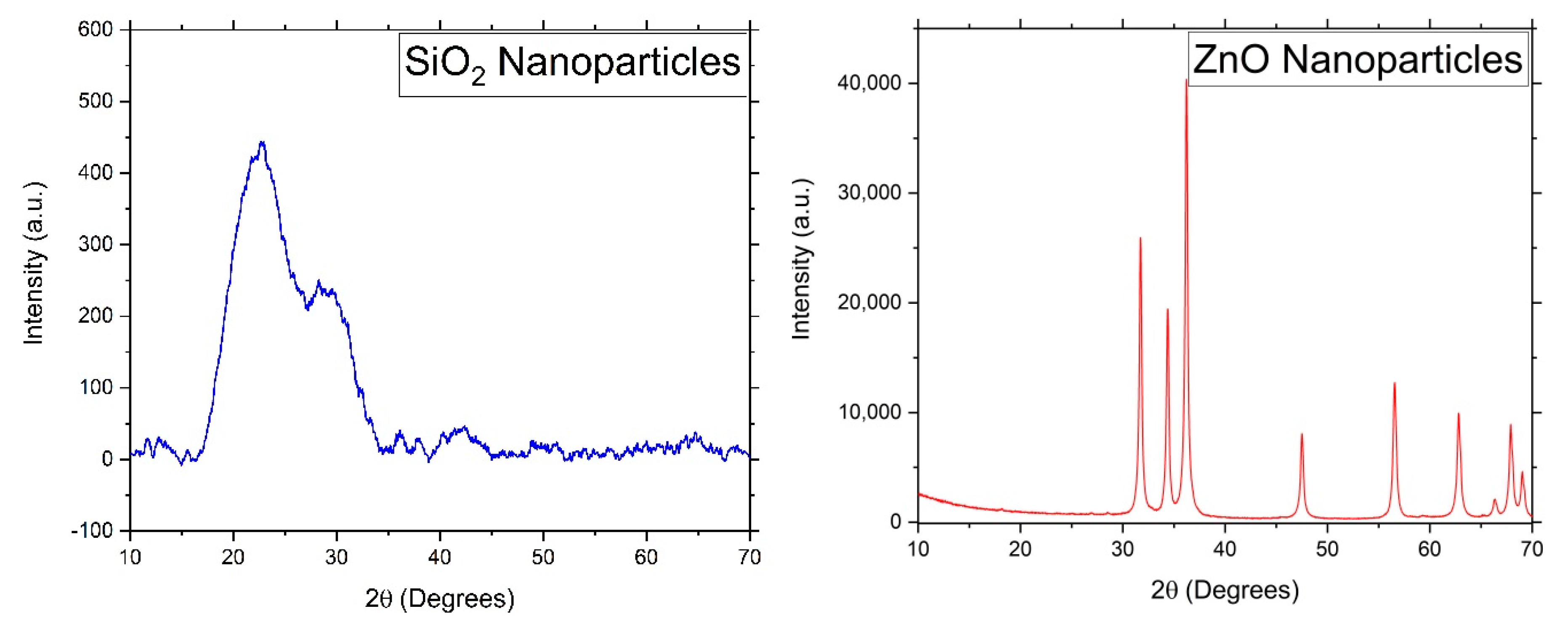
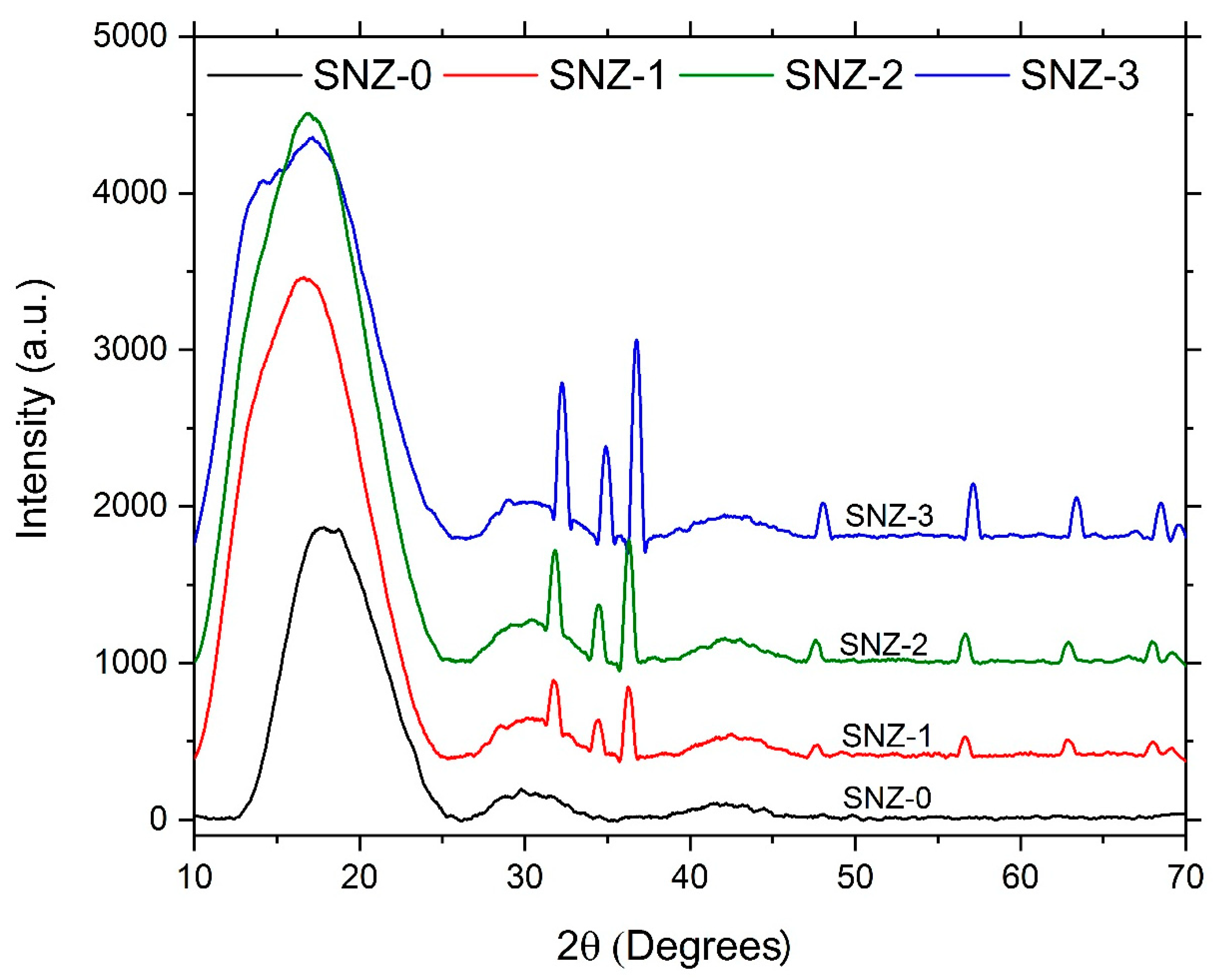
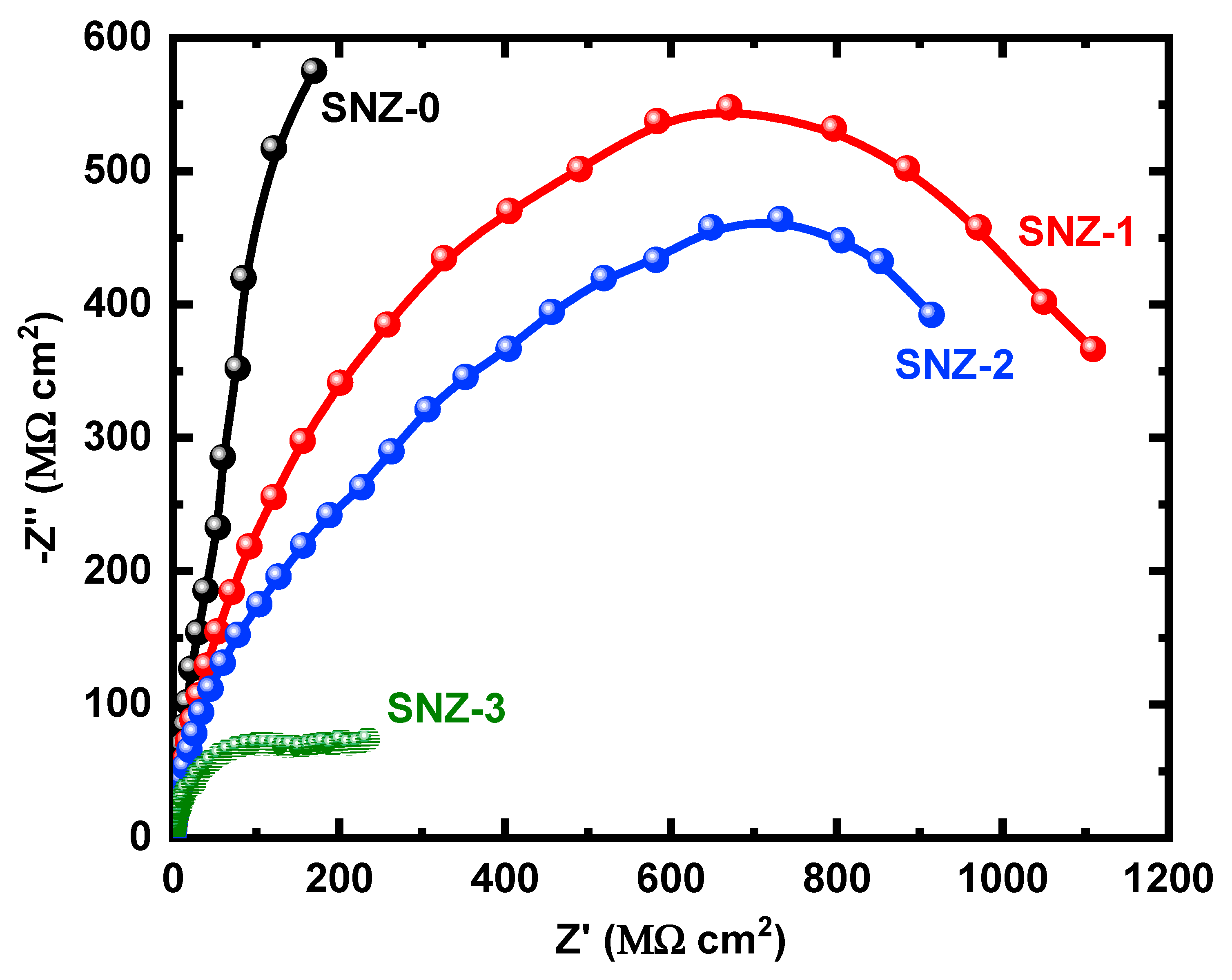
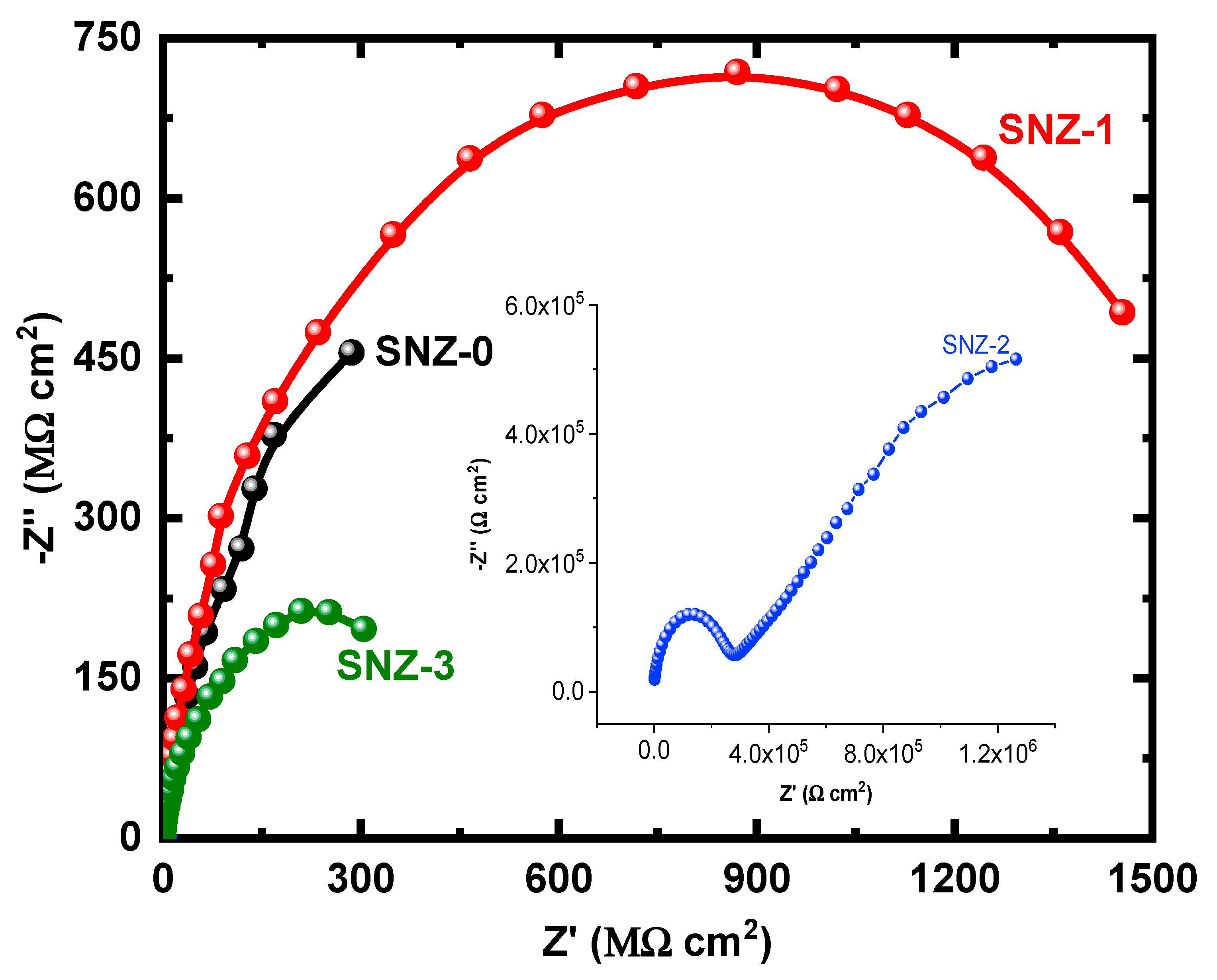


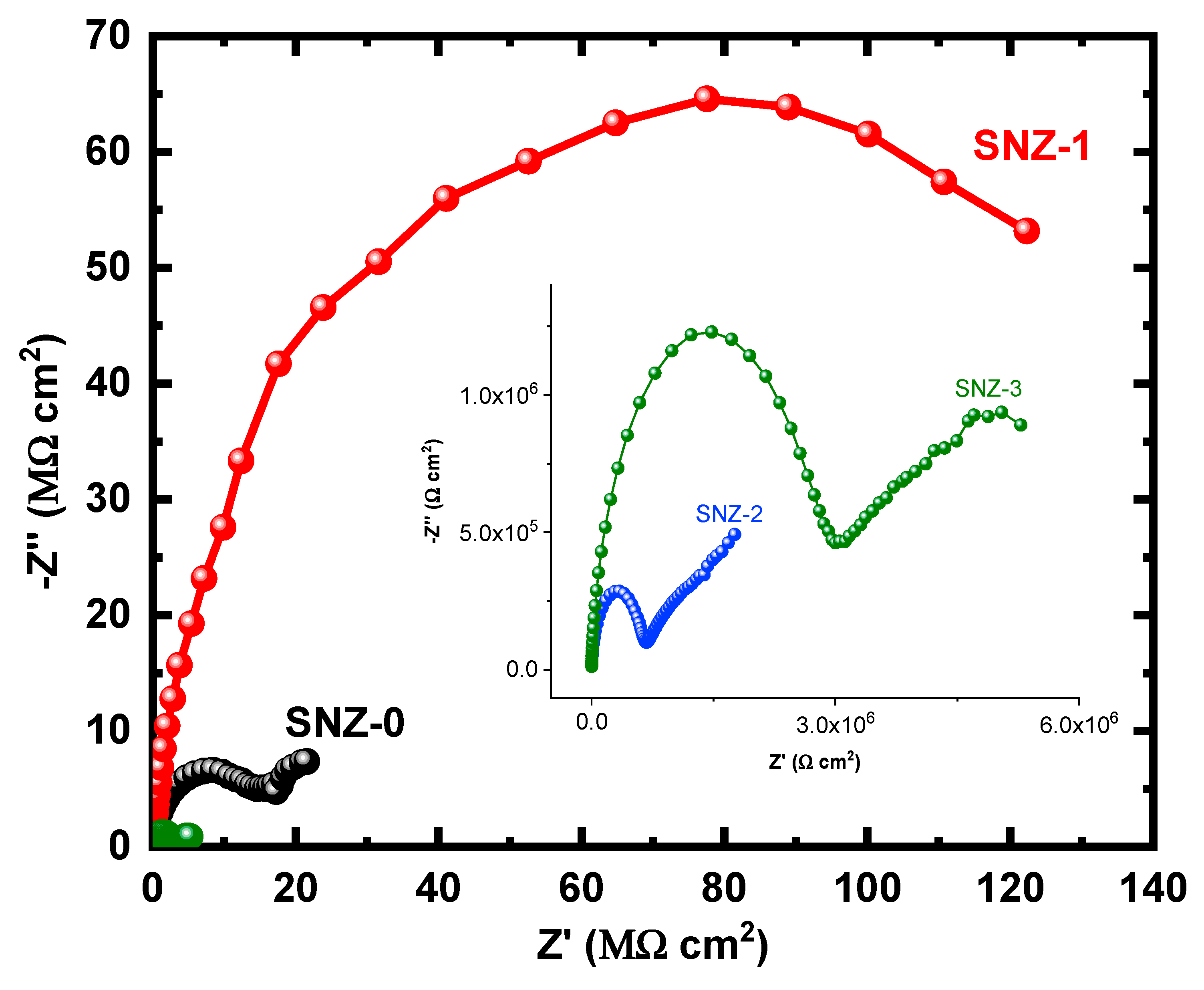
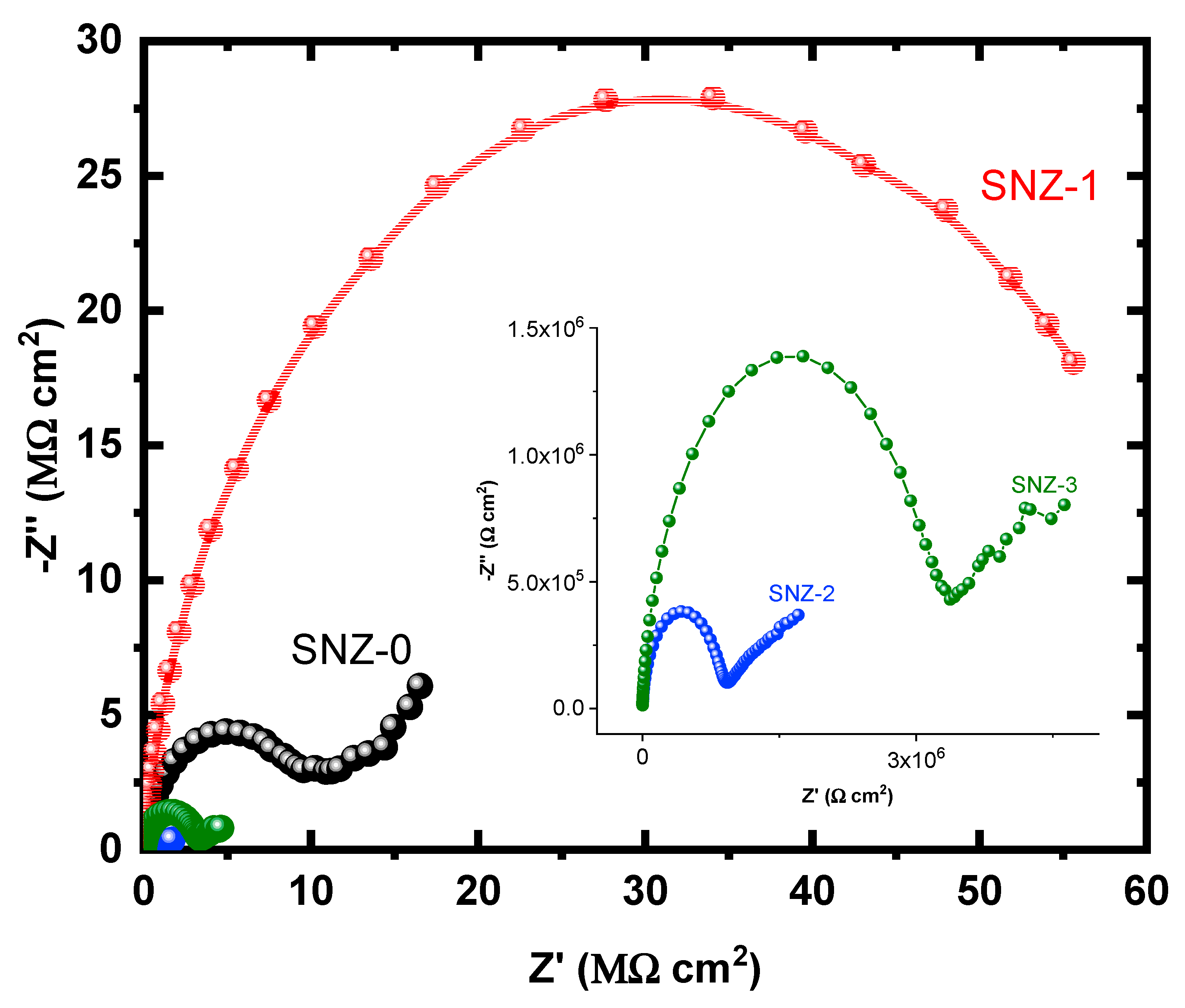
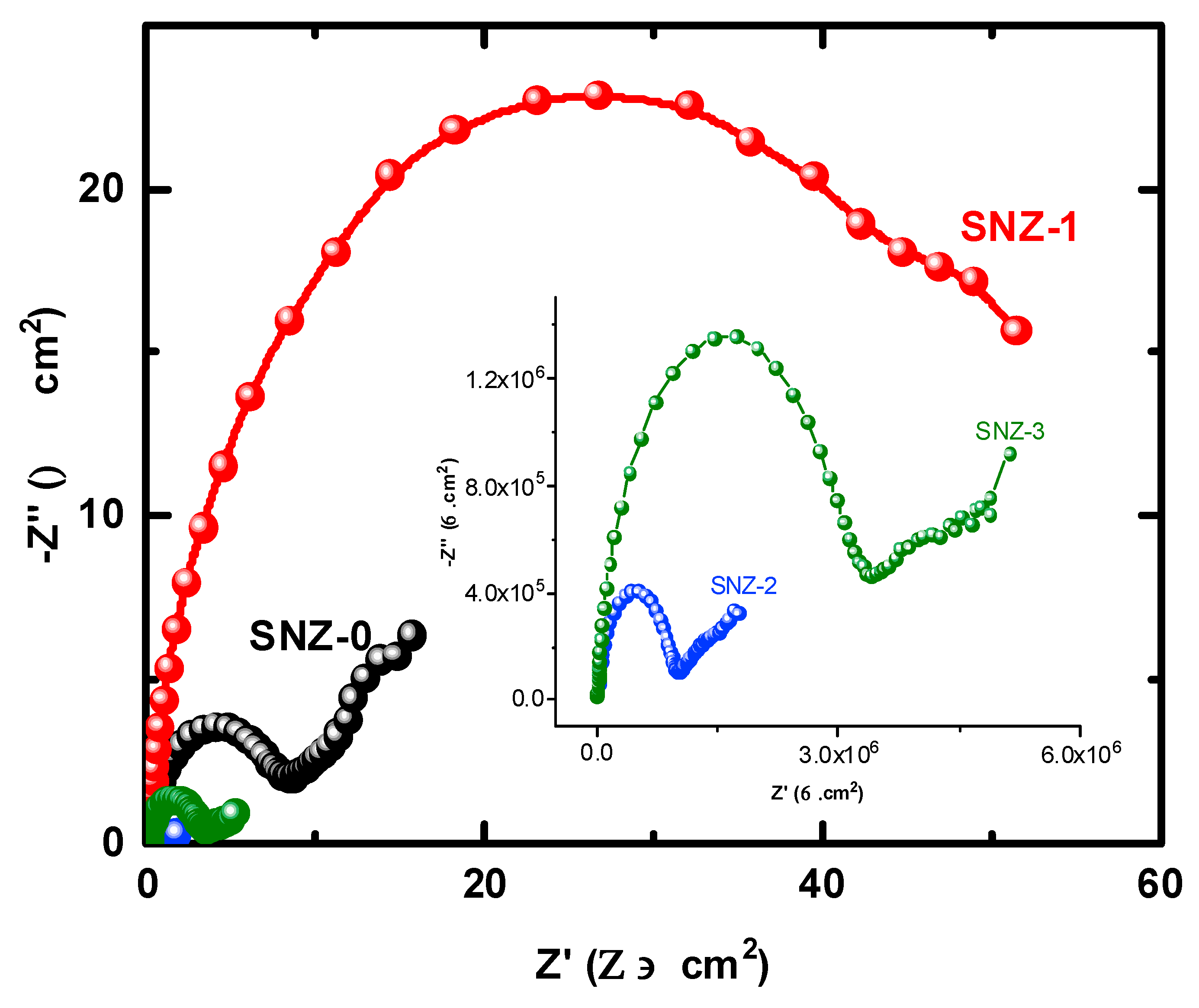

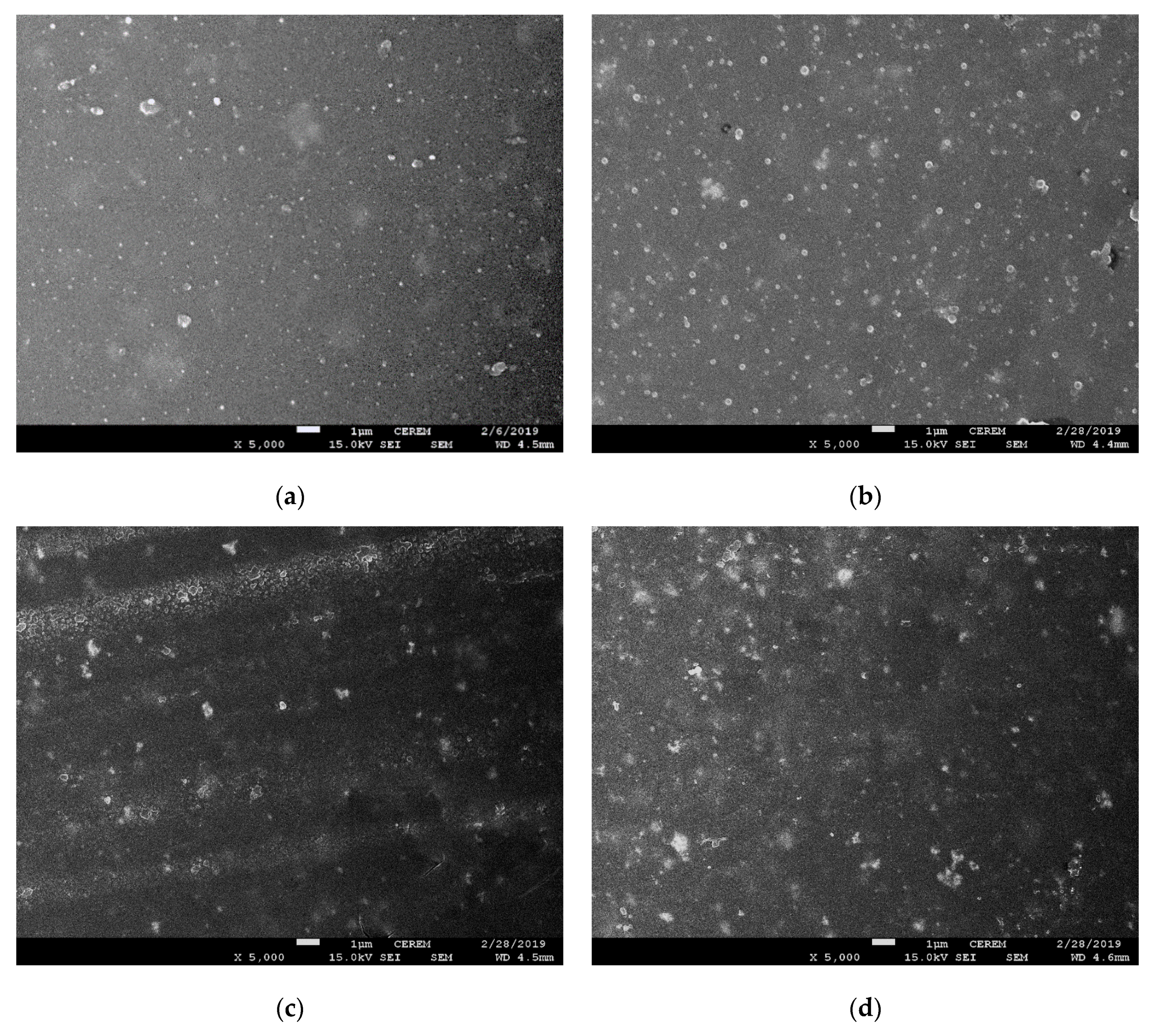
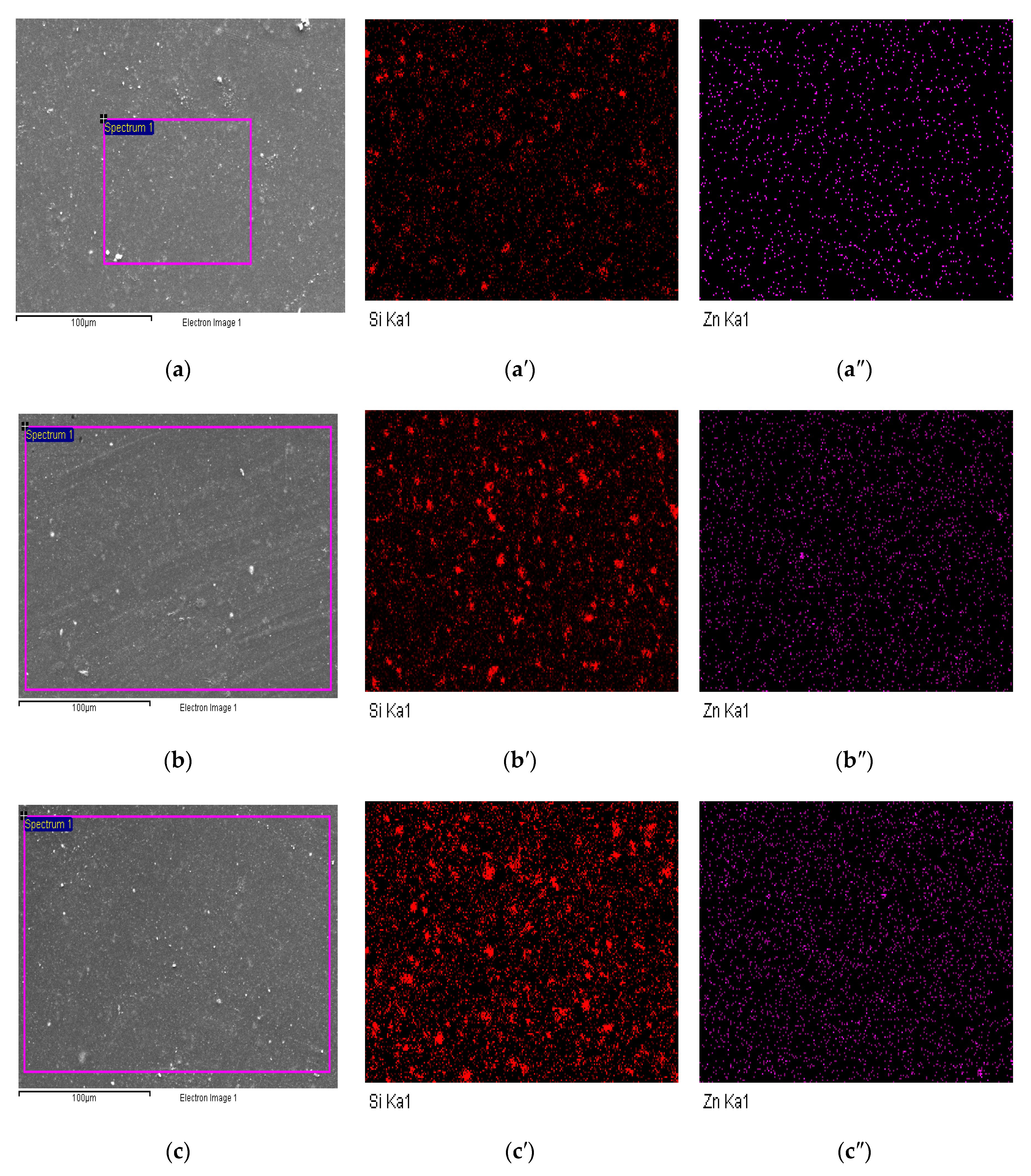
| Formulation Code | Resin | MIBK | Xylene | Modifier | SiO2 | ZnO | Hardener |
|---|---|---|---|---|---|---|---|
| SNZ-0 | 83.34 | 8 | 8 | 2.0 | 5 | 0 | 16.66 |
| SNZ-1 | 83.34 | 8 | 8 | 2.0 | 5 | 1 | 16.66 |
| SNZ-2 | 83.34 | 8 | 8 | 2.0 | 5 | 2 | 16.66 |
| SNZ-3 | 83.34 | 8 | 8 | 2.0 | 5 | 3 | 16.66 |
| Sample | Peak Position (2θ) | FWHM | d-Spacing (Å) | Crystallite Size (nm) | Lattice Strain |
|---|---|---|---|---|---|
| SiO2 | 19.58589 | 2.94332 | 4.528828 | 2.86 | 0.0744 |
| 22.57793 | 5.59728 | 3.934975 | 1.51 | 0.1223 | |
| ZnO | 31.73409 | 0.23328 | 2.817422 | 36.99 | 0.0036 |
| 34.38974 | 0.23302 | 2.605688 | 37.29 | 0.0033 | |
| 36.22022 | 0.24532 | 2.478091 | 35.6 | 0.0033 | |
| SNZ-0 | 16.65572 | 3.81686 | 5.31838 | 2.2 | 0.1138 |
| 19.59351 | 5.46692 | 4.527084 | 1.54 | 0.1381 | |
| SNZ-1 | 13.38835 | 3.07641 | 6.60806 | 2.72 | 0.1144 |
| 17.12733 | 7.5236 | 5.172983 | 1.12 | 0.218 | |
| 31.7897 | 0.54023 | 2.81262 | 15.98 | 0.0083 | |
| 34.42681 | 0.56117 | 2.602967 | 15.49 | 0.0079 | |
| 36.28277 | 0.50856 | 2.473962 | 17.18 | 0.0068 | |
| SNZ-2 | 13.25658 | 2.67718 | 6.673446 | 3.12 | 0.1005 |
| 17.17584 | 7.69235 | 5.158482 | 1.09 | 0.2223 | |
| 31.8155 | 0.5878 | 2.810398 | 14.68 | 0.009 | |
| 34.46997 | 0.54238 | 2.599806 | 16.02 | 0.0076 | |
| 36.30078 | 0.55318 | 2.472776 | 15.79 | 0.0074 | |
| SNZ-3 | 13.15965 | 2.91287 | 6.722382 | 2.87 | 0.1102 |
| 17.32535 | 8.01852 | 5.114302 | 1.05 | 0.2296 | |
| 32.10207 | 0.33925 | 2.785961 | 25.46 | 0.0051 | |
| 34.91708 | 0.53854 | 2.567533 | 16.16 | 0.0075 | |
| 36.75516 | 0.51518 | 2.443243 | 16.98 | 0.0068 |
| Coating | Time | EIS Parameters | ||||||
|---|---|---|---|---|---|---|---|---|
| Rs Ω cm2 | CPEc µF cm−2 | RP1 M Ω cm2 | CPEdl | RP2 M Ω cm2 | W Ω−1/2 | |||
| YQ/µF cm−2 | n | |||||||
| SNZ-0 | 1 h | 55.48 | 2.648 × 10−9 | 5.574 | 8.999 × 10−6 | 0.64 | 296.1 | - |
| 5 d | 57.96 | 2.123 × 10−9 | 6.571 | 2.999 × 10−6 | 0.59 | 3.493 | - | |
| 10 d | 58.12 | 5.815 × 10−9 | 6.987 | 8.125 × 10−8 | 0.75 | 4.516 | 2.222 × 10−8 | |
| 15 d | 58.41 | 2.333 × 10−8 | 9.298 | 2.087 × 10−8 | 0.80 | 5.361 | 4.358 × 10−8 | |
| 20 d | 58.96 | 8.087 × 10−9 | 8.112 | 3.793 × 10−9 | 0.83 | 14.76 | 1.787 × 10−7 | |
| 25 d | 59.32 | 2.421 × 10−9 | 9.501 | 3.673 × 10−9 | 0.85 | 9.711 | 2.800 × 10−7 | |
| 30 d | 59.87 | 7.64 × 10−10 | 9.685 | 3.757 × 10−9 | 0.88 | 7.957 | 3.810 × 10−7 | |
| SNZ-1 | 1 h | 42.04 | 1.233 × 10−9 | 4.496 | 3.771 × 10−10 | 0.80 | 109.9 | - |
| 5 d | 44.11 | 5.954 × 10−9 | 8.273 | 8.831 × 10−11 | 0.74 | 1760 | - | |
| 10 d | 48.32 | 1.321 × 10−9 | 2.281 | 1.112 × 10−9 | 0.69 | 36.80 | 2.222 × 10−8 | |
| 15 d | 49.14 | 7.49 × 10−11 | 3.243 | 8.399 × 10−11 | 0.48 | 1987 | 4.358 × 10−8 | |
| 20 d | 50.18 | 1.185 × 10−9 | 6.129 | 1.746 × 10−11 | 0.80 | 155.6 | 1.787 × 10−7 | |
| 25 d | 51.12 | 1.192 × 10−9 | 5.528 | 1.923 × 10−9 | 0.76 | 66.34 | 2.800 × 10−7 | |
| 30 d | 52.87 | 1.287 × 10−9 | 5..691 | 1.296 × 10−8 | 0.71 | 6.961 | 3.810 × 10−7 | |
| SNZ-2 | 1 h | 54.04 | 8.350 × 10−9 | 8.701 | 1.471 × 10−9 | 0.67 | 858.0 | - |
| 5 d | 56.23 | 9.07 × 10−10 | 8.962 | 6.845 × 10−8 | 0.63 | 448.3 | - | |
| 10 d | 55.81 | 9.52 × 10−10 | 9.180 | 4.762 × 10−7 | 0.63 | 1.277 | 4.611 × 10−6 | |
| 15 d | 56.24 | 9.60 × 10−10 | 9.319 | 7.006 × 10−7 | 0.54 | 1.506 | 6.735 × 10−6 | |
| 20 d | 54.98 | 9.70 × 10−10 | 9.398 | 1.452 × 10−6 | 0.26 | 1.355 | 1.826 × 10−7 | |
| 25 d | 56.39 | 9.91 × 10−10 | 9.562 | 1.578 × 10−6 | 0.21 | 2.131 | 4.316 × 10−7 | |
| 30 d | 57.54 | 9.91 × 10−10 | 9.846 | 1.365 × 10−6 | 0.17 | 2.659 | 4.612 × 10−7 | |
| SNZ-3 | 1 h | 57.81 | 1.126 × 10−9 | 8.927 | 2.713 × 10−9 | 0.69 | 181.4 | - |
| 5 d | 57.96 | 1.321 × 10−9 | 9.011 | 7.01 × 10−10 | 0.67 | 2.369 | - | |
| 10 d | 58.01 | 7.26 × 10−10 | 9.269 | 9.140 × 10−8 | 0.59 | 2.911 | 1.311 × 10−8 | |
| 15 d | 58.99 | 3.652 × 10−9 | 9.289 | 1.589 × 10−7 | 0.51 | 2.847 | 1.682 × 10−8 | |
| 20 d | 59.18 | 1.240 × 10−9 | 9.347 | 3.008 × 10−7 | 0.47 | 2.449 | 5.012 × 10−9 | |
| 25 d | 58.78 | 1.19 × 10−10 | 9.521 | 1.238 × 10−8 | 0.48 | 3.794 | 1.841 × 10−8 | |
| 30 d | 59.41 | 1.208 × 10−9 | 9.693 | 1.626 × 10−8 | 0.44 | 3.898 | 2.314 × 10−6 | |
| Sample Code | Nanoparticles | Elements | Percentages (wt.%) |
|---|---|---|---|
| SNZ-0 | SiO2 | C, O, Si | 76.24, 21.41, 2.34 |
| SNZ-1 | SiO2, ZnO | C, O, Si, Zn | 75.03, 21.62, 2.27, 1.08 |
| SNZ-2 | SiO2, ZnO | C, O, Si, Zn | 75.50, 20.40, 2.27, 1.83 |
| SNZ-3 | SiO2, ZnO | C, O, Si, Zn | 74.74, 20.24, 2.23, 2.79 |
© 2020 by the authors. Licensee MDPI, Basel, Switzerland. This article is an open access article distributed under the terms and conditions of the Creative Commons Attribution (CC BY) license (http://creativecommons.org/licenses/by/4.0/).
Share and Cite
Abdus Samad, U.; Alam, M.A.; Anis, A.; Sherif, E.-S.M.; Al-Mayman, S.I.; Al-Zahrani, S.M. Effect of Incorporated ZnO Nanoparticles on the Corrosion Performance of SiO2 Nanoparticle-Based Mechanically Robust Epoxy Coatings. Materials 2020, 13, 3767. https://doi.org/10.3390/ma13173767
Abdus Samad U, Alam MA, Anis A, Sherif E-SM, Al-Mayman SI, Al-Zahrani SM. Effect of Incorporated ZnO Nanoparticles on the Corrosion Performance of SiO2 Nanoparticle-Based Mechanically Robust Epoxy Coatings. Materials. 2020; 13(17):3767. https://doi.org/10.3390/ma13173767
Chicago/Turabian StyleAbdus Samad, Ubair, Mohammad Asif Alam, Arfat Anis, El-Sayed M. Sherif, Sulaiman I. Al-Mayman, and Saeed M. Al-Zahrani. 2020. "Effect of Incorporated ZnO Nanoparticles on the Corrosion Performance of SiO2 Nanoparticle-Based Mechanically Robust Epoxy Coatings" Materials 13, no. 17: 3767. https://doi.org/10.3390/ma13173767
APA StyleAbdus Samad, U., Alam, M. A., Anis, A., Sherif, E.-S. M., Al-Mayman, S. I., & Al-Zahrani, S. M. (2020). Effect of Incorporated ZnO Nanoparticles on the Corrosion Performance of SiO2 Nanoparticle-Based Mechanically Robust Epoxy Coatings. Materials, 13(17), 3767. https://doi.org/10.3390/ma13173767







